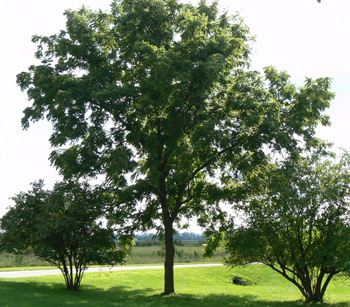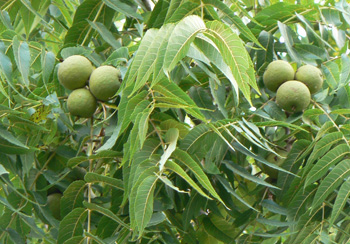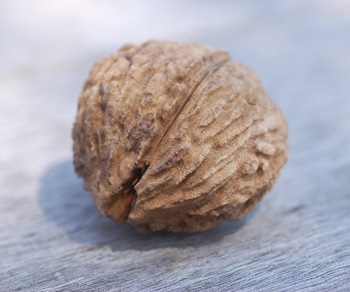Contents:
Common Names | Parts Usually Used | Plant(s) & Culture | Where Found | Medicinal Properties | Biochemical Information
Legends, Myths and Stories | Uses | Formulas or Dosages | Warning | Resource Links | Bibliography
Scientific Names

- Juglans nigra L.
- Juglandaceae
- Walnut family
Common Names
- Walnut
Parts Usually Used
Bark, leaves, rind of the fruit
Back to Top

Description of Plant(s) and Culture
Black walnut is a large, Temperate Zone forest tree growing to 120 feet; its bark is rough and dark. The leaves are pinnately compound, with 9-21 ovate lanceolate, serrate leaflets. Male and female flowers grow in separate catkins. The fruit is a deeply grooved nut inside a spherical, rough husk. October-November.
Back to Top
Where Found
Found in rich woods. Western Massachusetts to Florida; Texas to Minnesota. Canada
Back to Top
Medicinal Properties
Bark: astringent, laxative, alterative
Leaves: alterative
Rind: herpatic
Back to Top
Biochemical Information
Juglon (also called nucin or juglandic acid)
Back to Top

Legends, Myths and Stories
Black walnut produces the famous walnut wood of commerce, as well as the familiar edible nuts. Treats dog or man bites, painter’s oil, flavoring. Black walnut hulls are used for dyeing hair. Boil the hulls in 1 quart of water. Allow to steep until a very dark brew is obtained. Add copperas, the size of a pea, to set the dye. Strain and use as a hair rinse after shampoo. Repeat rinses until desired shade is acquired.
Back to Top
Uses
Use an infusion or decoction for diarrhea and to stop the production of milk. Use it as a douche for leukorrhea and as a mouthwash for soreness in the mouth or inflamed tonsils. The leaves can be used to make a cleansing wash, and the green rind of the fruit makes a good poultice to get rid of ringworm. Dried bark may be taken in a strong infusion as a purgative. The unripe nut kills intestinal worms. Chewing the bark is a remedy for toothache; an insecticide for bed bugs.
Rubbed on the skin, the extract of black walnut is said to help eczema, herpes, psoriasis, fungus infections, and skin parasites.
Native Americans used inner-bark tea as an emetic, laxative, chewed the bark for colic, poulticed for inflammation.
Back to Top
Formulas or Dosages
Tea: steep 1 oz. of either the bark or leaves in 1 cup water and take 2 or 3 times daily.
Extract: mix 10 to 20 drops in water or juice daily.
Externally: rub extract on skin 2 times daily.
Back to Top
Warning
Husk will stain anything it touches.
Back to Top
Resource Links
Mayo Clinic – Cholesterol: Top 5 foods to lower your numbers
PubMed.gov: Antihypertriglyceridemic effect of walnut oil.
PubMed.gov: Blood cholesterol and walnut consumption: a cross-sectional survey in France.
Bibliography
![]() The Herb Book
The Herb Book, by John Lust, Bantam Books, 666 Fifth Avenue, New York, NY. copyright 1974.
![]() The Herbalist Almanac
The Herbalist Almanac, by Clarence Meyer, Meyerbooks, publisher, PO Box 427, Glenwood, Illinois 60425, copyright 1988, fifth printing, 1994
![]() Eastern/Central Medicinal Plants
Eastern/Central Medicinal Plants, by Steven Foster and James A. Duke., Houghton Mifflin Company, 215 Park Avenue South, New York, NY 10000
![]() The Nature Doctor: A Manual of Traditional and Complementary Medicine
The Nature Doctor: A Manual of Traditional and Complementary Medicine, by Dr. H.C.A. Vogel; Keats Publishing, Inc., 27 Pine Street (Box 876) New Canaan, CT. 06840-0876. Copyright Verlag A. Vogel, Teufen (AR) Switzerland 1952, 1991
![]() Planetary Herbology
Planetary Herbology, by Michael Tierra, C.A., N.D., O.M.D., Lotus Press, PO Box 325, Twin Lakes. WI 53181., Copyright 1988, published 1992
![]() The Complete Medicinal Herbal
The Complete Medicinal Herbal, by Penelope Ody, Dorling Kindersley, Inc, 232 Madison Avenue, New York, NY 10016, First American Edition, copyright 1993
 Earl Mindell’s Herb Bible
Earl Mindell’s Herb Bible, by Earl Mindell, R.Ph., Ph.D., Simon & Schuster/Fireside, Rockefeller Center 1230 Avenue of the Americas, New York, New York 10020
![]() Indian Herbalogy of North America
Indian Herbalogy of North America, by Alma R. Hutchens, Shambala Publications, Inc., Horticultural Hall, 300 Massachusetts Avenue, Boston, Massachusetts 02115, 1973
![]() American Folk Medicine
American Folk Medicine, by Clarence Meyer, Meyerbooks, publisher, PO Box 427, Glenwood, Illinois 60425, 1973
![]() Webster’s New World Dictionary
Webster’s New World Dictionary, Third College Edition, Victoria Neufeldt, Editor in Chief, New World Dictionaries: A Division of Simon & Schuster, Inc., 15 Columbus Circle, New York, NY 10023
 An Instant Guide to Medicinal Plants
An Instant Guide to Medicinal Plants, by Pamela Forey and Ruth Lindsay, Crescent Books (January 27, 1992).
![]() The Yoga of Herbs: An Ayurvedic Guide to Herbal Medicine
The Yoga of Herbs: An Ayurvedic Guide to Herbal Medicine, by Dr. David Frawley & Dr. Vasant Lad, Lotus Press, Twin Lakes, Wisconsin, Second edition, 1988.
 The Rodale Herb Book: How to Use, Grow, and Buy Nature’s Miracle Plants (An Organic gardening and farming book)
The Rodale Herb Book: How to Use, Grow, and Buy Nature’s Miracle Plants (An Organic gardening and farming book), edited by William H. Hylton, Rodale Press, Inc. Emmaus, PA, 18049., 1974
